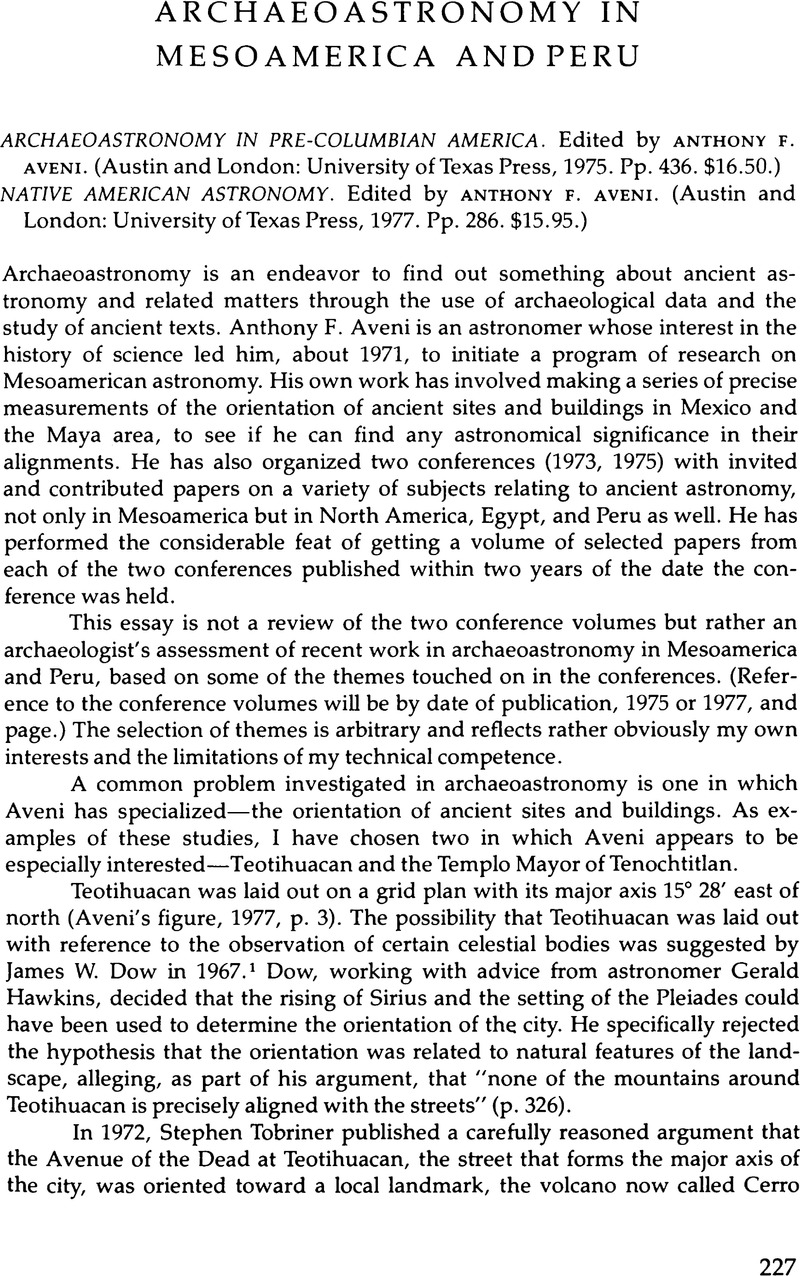Published online by Cambridge University Press: 24 October 2022

1. James W. Dow, “Astronomical Orientations at Teotihuacán: A Case Study in Astro-Archaeology,” American Antiquity 32, no. 3 (July 1967):326–34.
2. Stephen Tobriner, “The Fertile Mountain: An Investigation of Cerro Gordo's Importance to the Town Plan and Iconography of Teotihuacan,” in Mesa Redonda, Teotihuacan (México: Sociedad Mexicana de Antropología, 1972), pp. 103–15.
3. Doris Heyden, “An Interpretation of the Cave Underneath the Pyramid of the Sun in Teotihuacan, Mexico,” American Antiquity 40, no. 2 (Apr. 1975):131–47.
4. Alfred P. Maudslay, “A Note on the Position and Extent of the Great Temple Enclosure of Tenochtitlan and the Position, Structure, and Orientation of the Teocalli of Huitzilopochtli (Abstract),” in International Congress of Americanists, Proceedings of the XVIII Session, London, 1912 (London, 1913), part 1, pp. 173–75.
5. Fray Toribio de Benavente, Motolinía, Memoriales o libro de las cosas de la Nueva España y de los naturales de ella …, Edmundo O'Gorman, ed. (México: Universidad Autónoma de México, Instituto de Investigaciones Históricas, 1971), Serie de Historiadores y Cronistas de Indias, 2; Insert I occupies pp. 50–54, and the reference to the Templo Mayor is on p. 51.
6. Anthony F. Aveni and Sharon L. Gibbs, “On the Orientation of Pre-Columbian Buildings in Central Mexico,” American Antiquity 41, no. 4 (Oct. 1976):510–17.
7. Alfonso Caso, “Calendrical Systems of Central Mexico,” in Robert Wauchope, ed., Handbook of Middle American Indians 10 (Austin: University of Texas Press, 1971), pp. 333–48; Henry B. Nicholson, “Religion in Pre-Hispanic Central Mexico,” same volume, pp. 395–446.
8. George Kubler and Charles Gibson, The Tovar Calendar; an Illustrated Mexican Manuscript ca. 1585. Reproduced, with a Commentary and Handlist of Sources on the Mexican 365-Day Year. Memoirs of the Connecticut Academy of Arts & Sciences (New Haven, 1951).
9. Gerald S. Hawkins, “Prehistoric Desert Markings in Peru,” in Research Reports … 1967 (Washington, D.C.: National Geographic Society, 1974), pp. 117–44.
10. Bernabé Cobo, Historia del Nuevo Mundo, Marcos Jiménez de la Espada, ed. (Sevilla: Sociedad de Bibliófilos Andaluces, 1890–1895, 4 vols.), tomo 4, pp. 9–47 (lib. 13, caps. 13–16). Zuidema used a reprint published in 1956 in the Biblioteca de Autores Españoles, vols. 91–92. The reprint omits a shrine (11 on the sixth ceque of Chinchaysuyu) which is named and described in the original edition. Zuidema made a gratuitous emendation instead of checking the earlier publication (1977, p. 242).
11. Anonymous, “Discurso de la sucesión i gobierno de los Yngas,” in Víctor M. Maurtua, ed., Juicio de Límites entre el Perú y Bolivia; Prueba Peruana, tomo 8, Chunchos (Madrid, 1906), pp. 149–65. The reference is to p. 151. There is an incomplete edition from another copy of the manuscript (and hence with different errors) ed. by Julio A. Luna González-Polar, El Cuzco y el gobierno de los Incas (Lima: D. Miranda, 1962). In this edition, the reference is on p. 30.